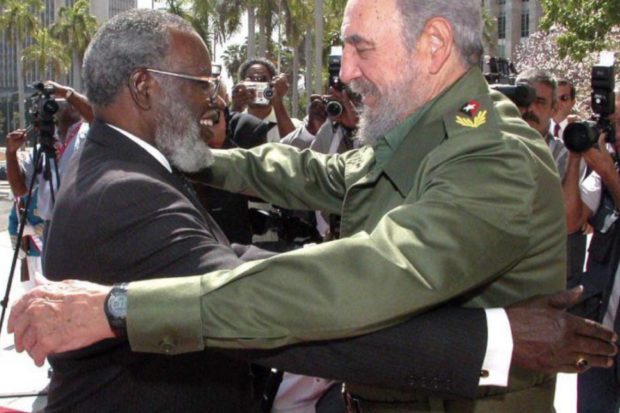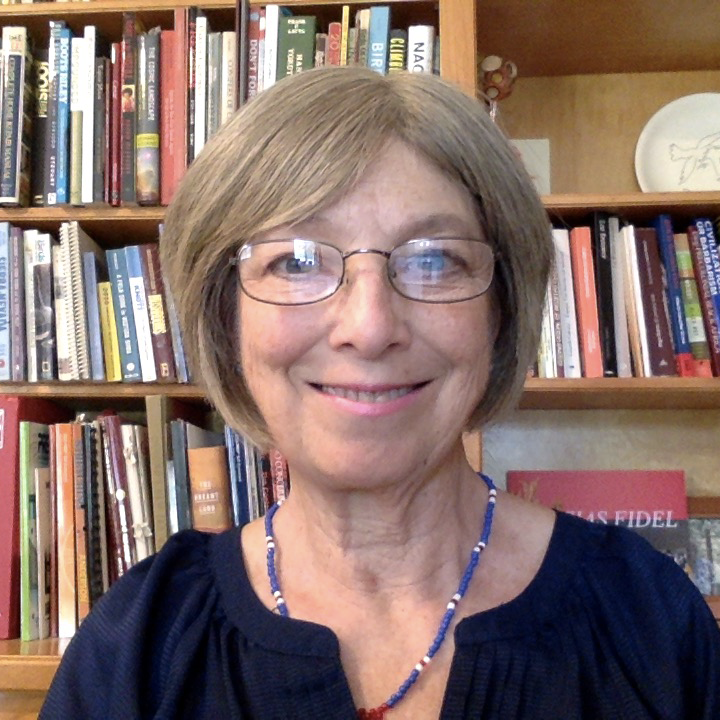
On May 13, the president of Cuba, Miguel Diaz-Canel Bermudez, sent congratulations to Sam Nujoma on his 94th birthday. Sam (Samuel Daniel Shafiishuna) Nujoma is the Father of His Country, and his country is Namibia. Namibia was called South-West Africa by the South African apartheid regime that ruled it. They had no intention of ever releasing their control.
Nujoma began working on the railroads as a young man and studied by correspondence. He began organizing workers. Then the South African apartheid government began “relocating” African people into homelands—removing them from their homes and lands by force.
SWAPO was formed to resist and struggle for liberation and an end to settler-colonialism, and Nujoma was elected its president. He presented a petition to the UN General Assembly demanding an end to South Africa’s colonial administration. The apartheid government was impervious to international opinion and UN resolutions.
Armed struggle began in August 1966, and Nujoma took a leading part. He continued to try for peaceful solutions as negotiations resumed in 1977–1978, leading to Resolution 435—supposedly an agreement by which the South Africans would allow elections in Namibia. Of course, South Africa had no intention of doing so until they could be sure of installing a puppet government and retaining control of the main port.
South African troops occupied Namibia and committed atrocities under the pretext of suppressing liberation actions. They killed livestock and poisoned wells, killed and scattered people to maintain a buffer zone at the Namibia-Angola border. Then South Africa crossed the border and invaded Angola itself.
What changed the South African policy and allowed Namibia to become free? The answer is Angola and Cuba.
Angola was an occupied colonial possession of Portugal. When Portugal agreed to Angolan independence in 1975, there were three rival “independence movements,” but not all were truly fighters for liberation and independence.
The FNLA was headed by Holden Roberto, a CIA asset; UNITA, backed by the United States and South Africa precisely because it was willing to cooperate with the apartheid regime in South Africa, was headed by charismatic psychopath Jonas Savimbi; and the MPLA (People’s Movement for the Liberation of Angola) was led by Agostinho Neto and concentrated on class, not ethnicity. MPLA was the only truly national, and the only real, liberation organization.
Civil war broke out in Angola in the spring of 1975, before the independence of November. By September, the United States and South Africa realized that the MPLA was winning, not because they were better armed (the United States and South Africa were arming the other organizations) but because they were more effective and more popular.
Washington urged Pretoria to intervene and on Oct. 14, 1975, South African regular troops invaded Angola, converting the civil war into an international conflict. It was not until Nov. 4, 1975, that Cuba sent troops in response to the MPLA’s appeals for help. U.S. government sources at the time tried to paint this as done “on orders from Moscow,” but over time even the most prejudiced U.S. warmongers (e.g., Henry Kissinger) had to admit that Cuba acted independently and that the USSR did not even begin to help until two months later.
Time went on, and so did the struggle.
In May 1978, South African troops attacked the Namibian refugee camp of Cassinga in southern Angola. Six hundred refugees were killed before Cuban troops were able to reach the area and defeat the South Africans.
In 1981, the United States, with Reagan in power, was sympathetic to the white South African government. The ANC (African National Congress—Nelson Mandela’s freedom movement) was the leading South African liberation force.
All of Southern Africa had to resist the South African attacks: Zimbabwe, Zambia, Lesotho, Swaziland, Botswana and Mozambique all suffered South African Defense Force raids, bombing, sabotage and targeted murders.
But Angola was the main victim of South African aggression for two reasons: It was the haven for the ANC guerrilla camps and for the SWAPO liberation forces of Namibia—Nujoma’s freedom movement. South Africa invaded Angola in August 1981 and gained control of the southern region of the country.
Mozambique’s President Samora Machel said that “the world has become accustomed to faits accomplis such as the illegal occupation of Guantanamo in Cuba and of a part of Angola by the South African racists. Nobody talks about Pretoria’s occupation of Angolan territory because it is just par for the course.”
Cuba again offered help in response to Angola’s plea. They sent arms, materiel, soldiers and aircraft to fight for liberty in Africa.
The struggle for freedom continued in Namibia. In 1983, South Africa designated the northern part of the country, where more than half the population lived, as an “Operational Area,” with a curfew and reign of terror; there were an estimated 20,000 South African troops in Namibia, in addition to colonial troops, only some of whom were volunteers. SWAPO, led by Nujoma, had only a few thousand guerrilla soldiers to oppose the South African army.
South Africa continued the invasion of Angola. Cuito Cuanavale was the turning point. Cuban and Angolan soldiers stopped the South African invasion. The South African racist government was never serious about negotiations or “linkage” or allowing elections or independence. Only a military defeat brought them to concede.
If the Cubans had not saved Cuito Cuanavale and maintained the Angolan-Namibian border, the South Africans would have dominated the southern part of Africa and prevented any independence or autonomy. “Cuba,” as Cuban representative in Angola Jorge Risquet said, “was not seeking a military victory but wanted an honorable agreement which has to be on the basis of independence in Namibia and the halting of foreign intervention in Angola.”
In May 1988, the South African army held a parade in northern Namibia to celebrate the 10th anniversary of the Cassinga massacre. The people of Namibia organized demonstrations and marches against the South African occupiers, followed by a general strike.
Armed struggle continued. The People’s Liberation Army of Namibia (PLAN), SWAPO’s military wing, waged a guerrilla struggle that ended in victory, with the South African forces capitulating to end its illegal occupation of Namibia in 1988.
In 1989, the implementation of UN Resolution 435 calling for free and fair elections under the supervision of the United Nations resulted in SWAPO coming to power, after 106 years of colonialism and a long hard battle for national liberation.
Namibia attained its hard-won independence on March 21, 1990, with Nujoma becoming the founding president of an independent and sovereign state, the Republic of Namibia. He served three terms, then stepped down.
Almost everyone else who participated in these historic events has gone to join the ancestors, including a late friend of the author, Lázaro Ostelaza Peña, a Cuban soldier in Angola in his youth. Asked why he volunteered, he said, “They needed our help.” Sam Nujoma is still with us: Happy birthday Sam Nujoma, and thank you!

